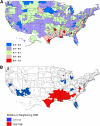Location, location, location: geographic clustering of lower-extremity amputation among Medicare beneficiaries with diabetes - PubMed (original) (raw)
. 2011 Nov;34(11):2363-7.
doi: 10.2337/dc11-0807. Epub 2011 Sep 20.
Affiliations
- PMID: 21933906
- PMCID: PMC3198303
- DOI: 10.2337/dc11-0807
Location, location, location: geographic clustering of lower-extremity amputation among Medicare beneficiaries with diabetes
David J Margolis et al. Diabetes Care. 2011 Nov.
Abstract
OBJECTIVE Lower-extremity amputation (LEA) is common among persons with diabetes. The goal of this study was to identify geographic variation and the influence of location on the incidence of LEA among U.S. Medicare beneficiaries with diabetes. RESEARCH DESIGN AND METHODS We conducted a cohort study of beneficiaries of Medicare. The geographic unit of analysis was hospital referral regions (HRRs). Tests of spatial autocorrelation and geographically weighted regression were used to evaluate the incidence of LEA by HRRs as a function of geographic location in the U.S. Evaluated covariates covered sociodemographic factors, risk factors for LEA, diabetes severity, provider access, and cost of care. RESULTS Among persons with diabetes, the annual incidence per 1,000 of LEA was 5.0 in 2006, 4.6 in 2007, and 4.5 in 2008 and varied by the HRR. The incidence of LEA was highly concentrated in neighboring HRRs. High rates of LEA clustered in contiguous portions of Texas, Oklahoma, Louisiana, Arkansas, and Mississippi. Accounting for geographic location greatly improved our ability to understand the variability in LEA. Additionally, covariates associated with LEA per HRR included socioeconomic status, prevalence of African Americans, age, diabetes, and mortality rate associated with having a foot ulcer. CONCLUSIONS There is profound "region-correlated" variation in the rate of LEA among Medicare beneficiaries with diabetes. In other words, location matters and whereas the likelihood of an amputation varies dramatically across the U.S. overall, neighboring locations have unexpectedly similar amputation rates, some being uniformly high and others uniformly low.
Figures
Figure 1
Maps of incidence of LEA among diabetic Medicare beneficiaries by HRR, 2008. A: Map of LEA incidence per 1,000 persons on Medicare with diabetes by HRR in 2008. B: Local index of spatial autocorrelation map of LEA incidence showing spatially correlated HRRs of highest incidence of LEA and lowest incidence of LEA in 2008.
Similar articles
- Lower-extremity amputation risk is associated with variation in behavioral risk factor surveillance system responses.
Margolis DJ, Hoffstad O, Weibe DJ. Margolis DJ, et al. Diabetes Care. 2014 Aug;37(8):2296-301. doi: 10.2337/dc14-0788. Epub 2014 May 30. Diabetes Care. 2014. PMID: 24879843 - Geographic variation of lower-extremity major amputation in individuals with and without diabetes in the Medicare population.
Wrobel JS, Mayfield JA, Reiber GE. Wrobel JS, et al. Diabetes Care. 2001 May;24(5):860-4. doi: 10.2337/diacare.24.5.860. Diabetes Care. 2001. PMID: 11347744 - Disparities in limb preservation and associated socioeconomic burden among patients with diabetes and/or peripheral artery disease in the United States.
McDermott KM, Bose S, Keegan A, Hicks CW. McDermott KM, et al. Semin Vasc Surg. 2023 Mar;36(1):39-48. doi: 10.1053/j.semvascsurg.2023.01.007. Epub 2023 Feb 3. Semin Vasc Surg. 2023. PMID: 36958896 Free PMC article. Review. - HbA1c and Lower Extremity Amputation Risk in Patients With Diabetes: A Meta-Analysis.
Zhou ZY, Liu YK, Chen HL, Yang HL, Liu F. Zhou ZY, et al. Int J Low Extrem Wounds. 2015 Jun;14(2):168-77. doi: 10.1177/1534734615593190. Epub 2015 Jun 29. Int J Low Extrem Wounds. 2015. PMID: 26130760 Review.
Cited by
- The feasibility of a social media-based foot self-management education and support program for adults with diabetes: A partially randomized preference trial.
Obilor HN, Veryha O, Weisz T, Botros M, Wilson R, Tranmer J, Woo K. Obilor HN, et al. PEC Innov. 2024 Jun 18;5:100307. doi: 10.1016/j.pecinn.2024.100307. eCollection 2024 Dec 15. PEC Innov. 2024. PMID: 39027228 Free PMC article. - Diabetic foot disease carries an intrinsic high risk of mortality and other severe outcomes in type 2 diabetes: a propensity score-matched retrospective population-based study.
Vlacho B, Bundó M, Llussà J, Real J, Mata-Cases M, Cos X, Tundidor D, Zaccardi F, Khunti K, Jude EB, Franch-Nadal J, Mauricio D. Vlacho B, et al. Cardiovasc Diabetol. 2024 Jun 19;23(1):209. doi: 10.1186/s12933-024-02303-1. Cardiovasc Diabetol. 2024. PMID: 38898525 Free PMC article. - Recent advances in molecular mechanisms of skin wound healing and its treatments.
Mamun AA, Shao C, Geng P, Wang S, Xiao J. Mamun AA, et al. Front Immunol. 2024 May 21;15:1395479. doi: 10.3389/fimmu.2024.1395479. eCollection 2024. Front Immunol. 2024. PMID: 38835782 Free PMC article. Review. - Regional and racial disparities in major amputation rates among medicare beneficiaries with diabetes: a retrospective study in the southeastern USA.
Lobo JM, Kang H, Brennan MB, Kim S, McMurry TL, Balkrishnan R, Anderson R, McCall A, Sohn MW. Lobo JM, et al. BMJ Public Health. 2023;1(1):e000206. doi: 10.1136/bmjph-2023-000206. Epub 2023 Dec 13. BMJ Public Health. 2023. PMID: 38764700 - A review of the current state of natural biomaterials in wound healing applications.
Ansari M, Darvishi A. Ansari M, et al. Front Bioeng Biotechnol. 2024 Mar 27;12:1309541. doi: 10.3389/fbioe.2024.1309541. eCollection 2024. Front Bioeng Biotechnol. 2024. PMID: 38600945 Free PMC article. Review.
References
- Sui DZ. Tobler's first law of geography: a big idea for a small world? Ann Assoc Am Geogr 2004;94:269–277
- Tobler WR. A computer movie simulating urban growth in the Detroit region. Econ Geogr 1970;46:234–240
- Margolis D, Malay DS, Hoffstad OJ, et al. Incidence of diabetic foot ulcer and lower extremity amputation among Medicare beneficiaries, 2006 to 2008. Data Points #2. Rockville, MD, Agency for Healthcare Research and Quality, U.S. Dept. of Health and Human Services, January 2011 (AHRQ Publ. No. 10[11]-EHC009-1-EF) - PubMed
- Boulton AJ. The diabetic foot: grand overview, epidemiology and pathogenesis. Diabetes Metab Res Rev 2008;24(Suppl. 1):S3–S6 - PubMed
